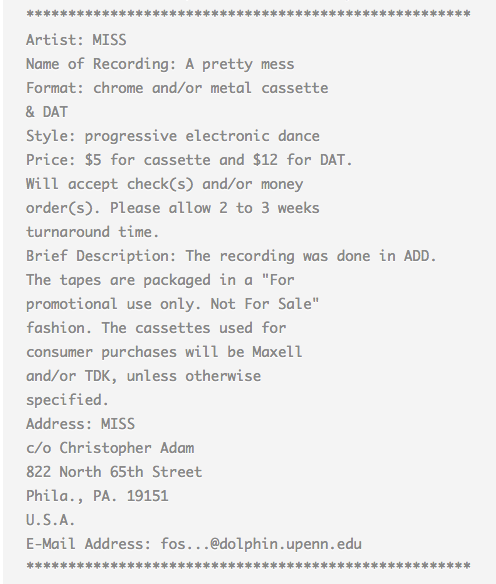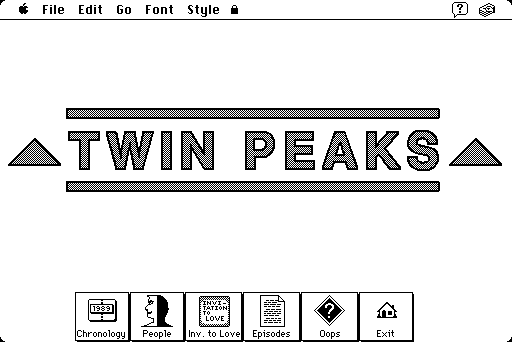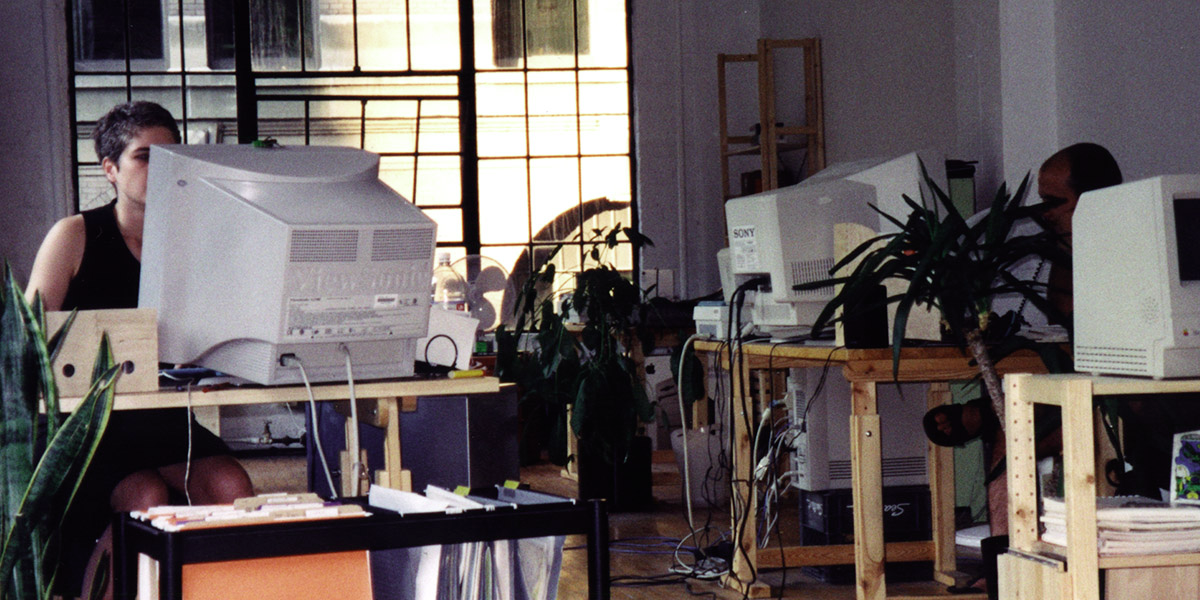This article is part one of a series of posts originally on Plank.co in honour of the company’s 20th anniversary. They have moved to this website since the posts are more personal, historical reflections and are better suited here.
Plank officially came into being in December of 1998, when we filed papers with the city of Montreal to register as a company. That day would never have come without a series of personal discoveries and chance meetings. This is the pre-history of Plank.
The Early Years

My introduction to computers happened in Grade 7 when I started programming on a TRS-80 at my school. My skills were rudimentary, and I have no clear memory of what I developed. I do remember proudly showing off what I’d built on a parent’s night at school, and my family showing up to cheer me on.
Soon enough, I discovered the Apple II, which lived at the Cote St. Luc library. It sounds very wholesome to say that I hung out at the library with my friends after school, but we just spent all our time playing games like Wizardry. We might as well have been sneaking into arcades to blow quarters on Donkey Kong.
In September 1984 I had my bar mitzvah and my bank account experienced a windfall. It was time to buy myself a computer. I guess I fancied myself something of a high roller, since I dismissed the more economical VIC-20 and Commodore 64, and went straight for the Apple IIe. I convinced my grandfather to drive me to get it. He and my mother were shocked and, frankly, disappointed when they learned how much I spent on that baby.
Even though I used that computer almost daily for the next 5+ years, I don’t think I ever managed to justify the cost of it. I played a lot of games, did a bit of number crunching, and some word processing. At that stage, my interest in computers had hit a hobby-level plateau. It was a toy and a curiosity, but I felt no drive to become a programmer or an engineer.
Looking back, I realize that during those years I was actually becoming a digital native. Starting in my pre-teen years in the 1980s I became extremely comfortable with computers, so that when the next set of discoveries came along, I was 100% ready to get on board.
Modems and BBSes and Internets!
When going online made noise.
My casual curiosity turned to outright obsession with my discovery of networked and internet computing in the early ‘90s. I knew about modems, and the possibilities of connection, but the concept remained abstract until I found BBSes, email, newsgroups, and IRC. I started to realize the possibility for learning, discussion, and building online communities. I was hooked. I started spending more and more time each day on my Mac Classic, getting to know new people who shared similar interests. In fact, I’m still friends with a few people that I met on those early BBSes set up in someone’s basement.

I quickly found a way to marry my passion for music and the internet, with a bonus of getting things delivered to my house for free. I loved independent music, and was looking for ways to discover bands in Montreal and beyond. As a bassist in a local band myself, I knew how hard it was to reach anyone beyond your own circle of friends. So I started the Indie Music Digest, an email mailing list.
The premise of the list was simple, every week I would email out a list of music by independent artists to anyone interested, so that they could discover a diverse community of musicians. All artists had to do to was send me some basic details, and I would add them. With no commercial intent, the only thing I asked for was that an artist sends me a copy of their cd/cassette/7-inch. I was more than happy to come home to a new package in the mail every few days! What I didn’t realize at the time was how much it was becoming an essential avenue for musicians and fans to connect.
I kept the project going for a few years, reaching over 10,000 subscribers, before the web took off and websites started to replace the need for my list. Eventually the early music site IUMA emailed and asked if they could use my list on their site and, with no profit motive in mind, I said sure. That was the end of the Indie Music Digest, but that project had given me a real taste for developing ways for people to connect through the things they love.
Communication Studies at Concordia University
My passion for digital was galvanized when I realized that I could use computers as a creative tool. I was a few years late to join the creative computing movement set off by the Apple Macintosh, but once I started to see concrete ways I could use digital tools, I became increasingly excited to learn more, and that’s why I joined the Communication Studies program at Concordia.
I found that the traditional production streams of the program (photography, sound, video and film) were less interesting to me than using the computer as a means of communication and creation. I enthusiastically joined the newly formed “Multimedia” stream, and embraced tools like PageMaker, Macromedia Director, Hypercard, Adobe Illustrator and Photoshop. Oh Photoshop 4.0, how I fell in love with you!
While my first trips down this creative avenue were through designing HyperCard Stacks and Director Presentations, by sharing things online. Once I started to see that I could accomplish the same creative output with HTML, my focus switched to the internet and building websites. I loved the idea that hundreds of millions of people could see my work. I also felt the
momentum around the growth of the internet, and I knew it was the thing for me.

More importantly, it was in this department that I met a lot of interesting and creative people that would inspire me, teach me, and eventually work with me. I had professors that would become clients, classmates who would become employees, and friends that would become collaborators. It was in Comms that I met Christiane Magee, who became a close friend and eventually — spoiler alert — co-founder of Plank.
Getting Paid for Passion Projects
One month out of university I registered my first company — Left Hand Communications — just in case people wanted to pay me money to develop websites for them. Funny enough, they did! Over the next 24 months, I worked on a slew of different projects, either freelance or with short stints at different companies. Each one of them helped to increase my confidence in my career, and moved me a step closer to founding Plank.
I want my MTV – and I almost got it!
One evening I stumbled upon a job post at MTV.com and had the audacity to apply. I was shocked when they emailed back the next day, and even more surprised when they offered me a job after one meeting at their Times Square office. Unfortunately, it was an entry-level position and they weren’t willing to invest in the legal fees to get this Canadian across the border.
I met Steve Bissonnette working on Leonard Nimoy’s Primortals CD-ROM
CD-ROMS, Futuresplash, and Future Partners
My first substantial contract was working on a CD-ROM Interactive Comic Book for Leonard Nimoy’s Primortals. I was in charge of assembling and animating the cells in Macromedia Director after they were created by the lead Photoshop designer. I quickly became friendly with him, and remembered him when it was time for Plank to hire our first employee. Needless to say, as a partner now 20 years later, Steve Bissonnette’s place at Plank worked out just fine.
A few months later I was hired as a “multimedia designer” at a technology start-up called Abilon which didn’t last long, unfortunately. My work there gave me the opportunity to collaborate on an early e-commerce website for Nine West Shoes. I was also given the opportunity to try out the first version of Futuresplash, a website animation technology that would develop into the infamous Adobe Flash.
I did a 6-month contract as a Creative Director at HBE Software, where I worked on a series of different websites, including the 1998 edition of the Fantasia Film Festival. I also managed to get a job there for one of my university friends, Christiane Magee. HBE had a very strong run and was funded around the time I left in December 1998.
Time to Put Down Roots
I wasn’t getting rich off of these projects, but they were paying my rent and giving me enough work to improve my design and coding skills. Oh, and I managed to pay off my student loans.
It was at HBE that I finally got the idea in my head that I could (and should) start a company of my own. While my experience was still fairly limited, I felt like the timing was right. I didn’t yet have the confidence to do it myself, so I asked a couple of people to start it with me. They both said yes.
Unfortunately, one of the partners only lasted for a few months, but the other stuck it out for over five years. That partner was Christiane Magee, who I was lucky enough to meet at Concordia, and who was instrumental in the founding of Plank and helping to shape its direction. Christiane moved on to other challenges in 2004, but she still drops by and borrows a desk here at Plank from time to time.


Leave a Reply